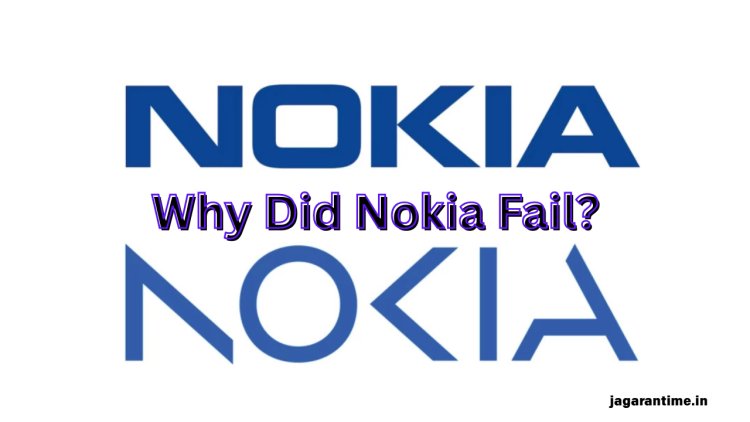Why Did Nokia Fail? A Giant’s Fall in the Mobile Revolution
Nokia once ruled the mobile world. Learn how software missteps, poor leadership, and slow innovation caused its shocking downfall.

In the early 2000s, Nokia was a household name, synonymous with mobile phones. From the sturdy Nokia 3310 to the stylish N-series, the Finnish company led the global mobile market with unmatched dominance. Yet, by the end of the decade, Nokia had lost its throne to companies like Apple, Samsung, and later Chinese brands like Xiaomi and Huawei.
So, what happened to Nokia? How did a company that once held over 40% of the global market share become irrelevant in the smartphone era? In this blog, we’ll uncover the real reasons behind Nokia’s fall—from technological arrogance and poor leadership to strategic missteps and the failure to adapt.
The Rise of Nokia: A Legacy of Innovation
Before diving into its failure, it’s important to understand how big Nokia was:
- In 1998, Nokia became the world’s largest mobile phone manufacturer.
- By 2007, it sold over 435 million handsets globally.
- It was known for reliability, durability, and long battery life.
- Nokia had a vast distribution network, especially in Asia and Europe.
Its success was built on 2G GSM networks, excellent hardware quality, and widespread carrier partnerships. But success sometimes breeds complacency—and that’s where Nokia’s decline began.
Reason 1: Over-Reliance on Symbian OS
One of Nokia’s major missteps was sticking with Symbian OS for too long. Symbian was once considered cutting-edge, but it became outdated quickly.
- It was complex for developers to code apps for.
- The user interface was not touch-friendly.
- When Apple launched the iPhone with iOS in 2007 and Google followed with Android in 2008, Symbian simply couldn’t compete.
Despite industry warnings, Nokia delayed transitioning to a modern operating system. It tried to retrofit Symbian for touchscreens, but the results were sluggish and buggy.
Reason 2: Innovation Paralysis and Internal Conflicts
Innovation at Nokia slowed dramatically because of bureaucracy and internal power struggles.
- Departments often worked in silos, with no unified product vision.
- Middle management feared change, rejecting bold ideas that could disrupt their own roles.
- Several prototypes, including touchscreen phones, were abandoned or delayed due to politics.
In contrast, Apple and Android embraced rapid innovation and user-centric design.
Reason 3: Poor Strategic Decisions
In 2011, Nokia shocked the industry by partnering with Microsoft and adopting Windows Phone OS instead of Android.
This decision proved disastrous:
- Windows Phone had limited apps and low developer support.
- It lacked the intuitive experience that iOS and Android offered.
- Consumers didn’t want to be stuck in a third ecosystem.
By the time Nokia realized its mistake, Android had already captured most of the market.
Reason 4: Ignoring Consumer Trends
Another key reason for Nokia’s failure was ignoring changing consumer behavior.
- The market shifted from feature phones to smartphones with touchscreens, large displays, and app ecosystems.
- Nokia stuck with keypad-based phones for too long.
- It underestimated how quickly consumers would adopt smartphones for media, internet, and productivity.
While Apple created a lifestyle around its devices, Nokia continued to focus on hardware specs, missing the software-first revolution.
Reason 5: Too Slow to Adapt
The mobile industry evolves fast, and Nokia was too slow to react:
- It took 4 years after the iPhone launch to release a truly competitive smartphone.
- While Android was growing at an exponential rate, Nokia was still testing internal prototypes.
- Its first real attempt at a modern smartphone—the Lumia series—was well-received in terms of design but came too late.
In tech, being late is often worse than being wrong.
Reason 6: Leadership Crisis
Nokia’s leadership, particularly during the transitional years (2005–2013), lacked clarity and courage.
- CEOs like Olli-Pekka Kallasvuo and Stephen Elop failed to align the company’s strengths with market realities.
- Elop’s infamous “burning platform” memo painted a grim picture but didn’t provide an actionable rescue strategy.
- His decision to shift entirely to Windows Phone led to a deeper decline.
Eventually, Nokia’s mobile division was sold to Microsoft in 2014 for $7.2 billion—a massive fall for a once-$100 billion brand.
Reason 7: App Ecosystem Failure
In the modern smartphone era, apps matter more than hardware.
- The iPhone and Android succeeded partly because of their App Store and Google Play Store.
- Nokia’s app store (Ovi Store) was underdeveloped, buggy, and lacked third-party developer support.
- By the time Windows Phone launched, it had less than 1% of the app market.
Users want access to services like WhatsApp, Instagram, YouTube, and hundreds of games. Without a strong app ecosystem, Nokia phones became obsolete in the eyes of users.
???? The Final Blow: Acquisition by Microsoft
In 2014, Nokia sold its mobile business to Microsoft, which rebranded the Lumia line under its own name. But the partnership didn’t work:
- Microsoft’s mobile division continued to fail.
- In 2016, Microsoft wrote off $8 billion related to Nokia.
- Nokia essentially disappeared from the mobile space for a few years.
Though HMD Global later revived the Nokia brand with Android, it never returned to its former glory.
Summary of Why Nokia Failed:
|
Reason |
Description |
|
Symbian Obsession |
Outdated OS that couldn't compete with iOS/Android |
|
Internal Politics |
Innovation was blocked by bureaucracy |
|
Bad Strategy |
Partnered with Microsoft instead of choosing Android |
|
Consumer Blindness |
Failed to see smartphone revolution |
|
Slow Response |
Took too long to act on changing market |
|
Leadership Failure |
CEOs lacked vision and unity |
|
Weak App Ecosystem |
No support from developers or users |
Lessons for Tech Companies
Nokia’s fall serves as a cautionary tale:
- In tech, you must adapt or die.
- Hardware is important, but software and ecosystems matter more.
- Innovation must be a continuous process, not a one-time breakthrough.
- Listening to consumers and developers is essential for survival.
Today, the likes of Apple, Google, and Samsung dominate because they never stop evolving. Had Nokia embraced Android in 2010, the smartphone industry might look very different today.
Disclaimer:
This article is for informational purposes only. The views expressed here are based on public historical events and industry analyses. Readers are encouraged to explore additional business case studies and leadership research for deeper insights.













